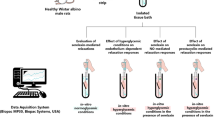Abstract
The potential of ATP-sensitive potassium channel openers (KCOs) for the treatment of male erectile dysfunction has recently been suggested based on positive clinical outcomes following intra-cavernosal administration of pinacidil. Agents that increase the levels of cGMP via elevation of nitric oxide (NO) nitroglycerin, for example, are also effective in improving erectile function preclinically and clinically. The aim of the present study was to determine the effects and mechanism of the action of nicorandil on rabbit corpus cavernosum. The in vitro regulation of smooth muscle tone was assessed in isolated cavernosal tissues pre-contracted with phenyl-ephrine. Nicorandil, but not its major metabolite, relaxed phenylephrine-precontracted cavernosum smooth muscle with an EC50 of 15 μM. The effects of nicorandil were only partially reversed by the KATP channel blocker glyburide (10 μM) or by a soluble guanylate cyclase (sGC) inhibitor 1H-[1,2,4] oxadiazole [4,3-a] quinoxalin-1-one (ODQ, 3 μM). However, a combination of ODQ and glyburide completely blocked the relaxant effects of nicorandil. The results of the present study indicate that nicorandil can relax rabbit cavernosal tissue in vitro via a mechanism that involves activation of KATP channels and stimulation of soluble guanylate cyclase.
This is a preview of subscription content, access via your institution
Access options
Subscribe to this journal
Receive 8 print issues and online access
$259.00 per year
only $32.38 per issue
Buy this article
- Purchase on Springer Link
- Instant access to full article PDF
Prices may be subject to local taxes which are calculated during checkout
Similar content being viewed by others
References
Moreland RB, Nakane M, Hsieh GC, Brioni JD . Prospectives for pharmacotherapy of male erectile dysfunction. Current Opinions CPNS Drugs 2000 2, 283–302
Traish AM, Kim NN, Goldstein I, Moreland, RB . Alpha adrenergic receptors in the penis. J Androl 1999 20, 671–682
Burnett A . Nitric oxide in the penis: physiology and pathology. J Urol 1997 157, 320–324
Meinhardt W, Kropman RF, Vermeij P . Comparative tolerability and efficacy of treatment for impotence. Drug Safety 1999 20, 133–146
Leopold JA, Loscalzo J . New developments in nitrosovasodilator therapy. Vasc Med 1997 2, 190–202
Lawson K . Potassium channel openers as potential therapeutic weapons in ion channel disease. Kidney Int 2000 57, 838–845
Lee SW, Wang HZ, Christ GJ . Characterization of ATP-sensitive potassium channels in human corporal smooth muscle cells. Int J Impot Res 1999 11, 179–188
Trigo-Rocha F et al. The effect of intracavernous injection of potassium channel openers in monkeys and dogs. Int J Impot Res 1995 7, 41–48
Giraldi A, Wagner G . Effects of pinacidil upon penile erectile tissue, in vitro and in vivo Pharmacol Toxicol 1990 67, 235–238
Holmquist F, Andersson KE, Fovaeus M, Hedlund H . K (+)-channel openers for relaxation of isolated penile erectile tissue from rabbit. J Urol 1990 144, 146–151
Moon DG, Byun HS, Kim JJ . A K-ATP channel opener as a potential treatment modality for erectile dysfunction. Br J Urol Int 1999 83, 837–841
Goldschmidt M, Landzberg BR, Frishman WH . Nicorandil: a potassium channel opening drug for treatment of ischemic heart disease. J Clin Pharmacol 1996 36, 559–572
Hedlund P, Holmquist F, Hedlund H, Andersson KE . Effects of nicorandil on human isolated corpus cavernosum and cavernous artery. J Urol 1994 151, 1107–1113
Gopalakrishnan M et al. Characterization of the ATP-sensitive potassium channels (K-ATP) expressed in guinea pig bladder smooth muscle cells. J Pharmacol Exp Ther 1999 289, 551–558
Christ GJ et al. Intracorporal injection of hSIo cDNA in rats produces physiologically relevent alterations in penile function. Am J Physiol 1998 275, H600–H608
Lee SW, Wang HZ, Christ GJ . Characterization of ATP-senstive potassium channels in human corporal smooth muscle cells. Int J Impot Res 1999 11, 179–198
Fan SF, Brink PR, Melman A, Christ GJ . An analysis of the maxi-K+ (KCa) channel in cultured human corporal smooth muscle cells. J Urol 1995 153, 818–825
Giraldi A et al. Differential relaxation of human corpus cavernosum smooth muscle by potassium openers: evidence that relaxation is both agonist dependent and altered by diabetes melitus. Int J Impot Res 1995 7, 1–10
Vick RN, Patel M, Benevides M, Carson CC . The efficacy, safety, and tolerability of intracavernosal PNU-83587 in the treatment of erectile dysfunction. J Urol 2000 163, 20
Quast U . Potassium channel openers: pharmacological and clinical aspects. Fundam Clin Pharmacol 1992 6, 279–293
Garthwaite J et al. Potent and selective inhibition of nitric oxide-sensitive guanylyl cyclase by 1H-[1,2,4]oxadiazolo[4, 3-a]quinoxalin-1-one. Mol Pharmacol 1995 48, 184–188
Denninger JW, Marletta MA . Guanylate cyclase and the NO/cGMP signaling pathway. Biochim Biophys Acta 1999 1411, 334–350
Zhao Y, Brandish PE, Ballou DP, Marletta MA . A molecular basis for nitric oxide sensing by soluble guanylate cyclase. Proc Natl Acad Sci USA 1999 96, 14753–14758
Denninger JW et al. Interaction of soluble guanylate cyclase with YC-1: kinetic and resonance Raman studies. Biochemistry 2000 39, 4191–4198
Berdeaux A et al. Differential effects of nitrovasolidators, K channel openers and nicorandil on large and small coronary arteries in conscious dogs. J Cardiovasc Pharmacol 1992 20, (Suppl 3): S17–S21
Acknowledgements
The authors are grateful to Dr Robert B Moreland for his valuable comments on the manuscript.
Author information
Authors and Affiliations
Corresponding author
Rights and permissions
About this article
Cite this article
Hsieh, G., Kolasa, T., Sullivan, J. et al. Dual mechanism of action of nicorandil on rabbit corpus cavernosal smooth muscle tone. Int J Impot Res 13, 240–246 (2001). https://doi.org/10.1038/sj.ijir.3900702
Received:
Accepted:
Published:
Issue Date:
DOI: https://doi.org/10.1038/sj.ijir.3900702
Keywords
This article is cited by
-
Phentolamine relaxes human corpus cavernosum by a nonadrenergic mechanism activating ATP-sensitive K+ channel
International Journal of Impotence Research (2005)



